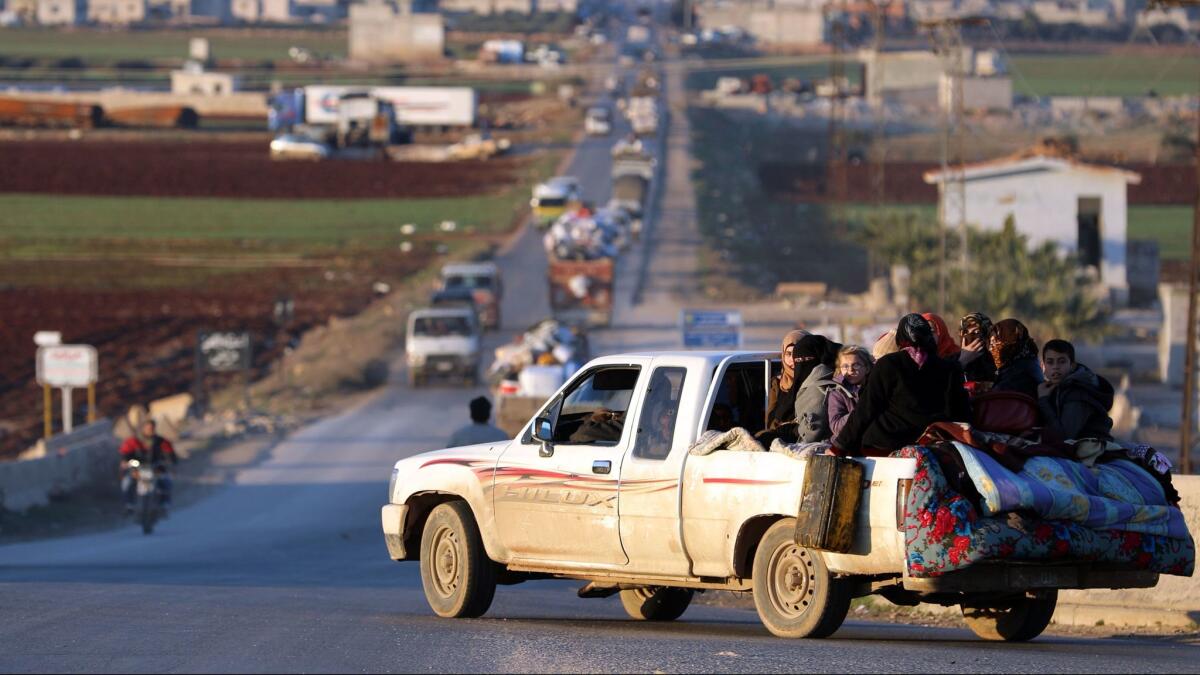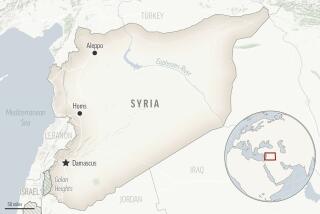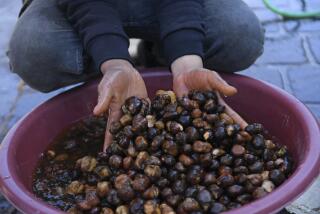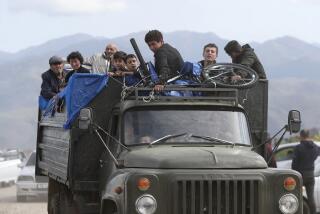Tens of thousands flee, fearing fresh violence in Syria’s Idlib province

Before civil war devastated Syria, the northwestern province of Idlib was known for its olive groves and the abandoned but well-preserved archaeological remains of the so-called Dead Cities.
In the years since fighting erupted in 2011, Idlib became the largest rebel-held territory in the northern part of the country, and it remains home to many of President Bashar Assad’s most implacable foes.
Now, with opposition forces facing defeat in other parts of Syria, the Assad government has turned its sights to Idlib.
The estimated 2 million people living there face a grim choice: Stay and risk being killed in the fighting, or flee toward the Turkish border to the north in the brutal Idlib winter with no shelter.
More than 130,000 people have opted for the latter, according to figures provided this week by the Turkish IHH Humanitarian Relief Foundation. The exodus came as the government’s elite Tiger Forces, backed by a ferocious barrage of airstrikes and shelling, advanced hundreds of square miles in recent weeks and stormed dozens of rebel-held villages.
Government forces appeared poised Tuesday to take Abu Duhur, a strategic military air base where more than 56 government soldiers were executed by the Al Qaeda affiliate formerly known as Al Nusra Front when its fighters overran the base in 2015, according to Syrian state media and other pro-government outlets.
“We’ve been seeing hundreds of vehicles on the road, all of them leaving their areas and heading northward,” Ahmad Barakat, a 50-year-old cowherd living near Idlib city, said in a phone interview Monday.
Pro-opposition activists uploaded videos and images of trucks with teetering piles of furniture as they drove past. People clung to the sides of vehicles or rode under a tarpaulin cover with their livestock.
Barakat said prices of items have plunged to less than 50% in some cases, as people seek to offload what possessions they own before they travel. But he insisted he and his family were staying put.
“Where can you go? Turkey? The borders are closed, and it’s too cold,” he said. “You have nothing before you but death.”
For many in Idlib, this is not the first time they have been uprooted. Faced with crushing government sieges, the rebels who once held sway in Aleppo and other opposition enclaves throughout the country acquiesced to so-called reconciliation deals, which allowed them to stay in their areas on condition of laying down their arms, or leave for Idlib.
The United Nations believes 1 million people in Idlib are among Syria’s internally displaced.
Those people “left their homes in other parts of Syria and came to Idlib looking for safety. Now they’re displaced again, and when they arrive at settlements, the capacity is limited and services are overstretched,” said Rula Amin, Middle East and North Africa spokeswoman for the Office of the United Nations High Commissioner for Refugees, in a phone interview Tuesday.
“Conditions for those fleeing are dire: Not enough shelters, not enough toilets, not enough showers…. At some sites, the needs are 400% over what is available, and it’s not clear how this escalation will unfold,” she said.
Turkish charities such as IHH have been building new shelters and providing food, but Abdulsalam Shareef, IHH’s Gaziantep Office coordinator, said refugees were running out of space, even as aid organizations face donor fatigue after a nearly seven-year crisis.
“Those 100,000 who came now? They live in peasant grounds under olive trees, and it’s muddy. When it rains, your foot sinks … into the ground. So a tent sinks in and you see mud and water going inside it. It’s a real catastrophe,” Shareef said in a phone interview Monday.
“And now there is no funding like before, so we’re barely able to cover our feeding and drinking expenses, and we have less tents, blankets, heaters, pillows and insulators,” he said.
In the early years of the civil war, Idlib became the site of fierce anti-government resistance, with much of the province’s majority Sunni Muslim population participating in uprisings.
Rebel factions flourished, taking advantage of Turkish authorities’ carte blanche to cross to ferry men and materiel, supplied by Turkey or the opposition’s Western allies, to fight Assad’s troops.
By 2015, a loose coalition of Islamist groups known as the Army of Conquest, and which included Al Nusra Front, had driven out remaining government forces.
Since last year, however, the once-powerful Islamist factions have fallen prey to infighting, while the Western arms support dried up for fear of weapons getting into the hands of extremists.
Al Nusra Front (which rebranded itself as the Organization for the Liberation of Syria, or Hayat Tahrir al Sham) emerged as the top authority in Idlib and did away with both its Western-supported rivals and its onetime jihadi allies, such as the hard-line Islamist group Ahrar al Sham.
Pro-opposition activists and other rebel groups accused Hayat Tahrir al Sham of allowing government troops to enter Idlib virtually unopposed.
“The regime’s rapid advance in Idlib is due to the behavior of Hayat Tahrir al Sham, which dismantled the factions and weakened them,” said Ahrar al Sham in a general call to arms issued Sunday.
But the group’s leaders denied any collusion, posting photos on its dedicated Telegram channel that show attacks on government troops.
Opposition leaders and activists suspected the weak resistance was because of a joint de-escalation agreement forged by Russia, Iran and Turkey in the Kazakh capital, Astana, in September.
Russia and Iran are Assad’s most ardent international supporters, and Turkey has emerged as the rebels’ top backer. The de-escalation agreement had reduced the intensity of government and Russian airstrikes on Idlib.
It was unclear how the recent advance by government forces, including the capture of more than a dozen villages Monday, fit into the de-escalation agreement.
Any clarity might come from Russia, Iran or Turkey as the forces behind the agreement, Reem Ismail, a spokeswoman for special envoy Staffan de Mistura, the U.N. official in charge of peace talks between Damascus and the rebels, said in an email Tuesday.
The push by the Tiger Forces appears aimed at consolidating Damascus’ grip over areas south of Aleppo and reducing rebel presence near the M5, the backbone highway that links the country’s major cities, according to pro-government and pro-rebel activists.
Yet it remains to be seen whether government forces will stop at Abu Duhur, the purported end point of the area assigned to Damascus in the de-escalation agreement.
Also Tuesday, Syria’s military accused Israel of launching missiles at military outposts in the Damascus countryside, and the U.S. responded to a Russian Defense Ministry statement about drone attacks on Russian bases in Syria by denying involvement in any such attacks.
Bulos is a special correspondent.
Twitter: @nabihbulos
More to Read
Start your day right
Sign up for Essential California for news, features and recommendations from the L.A. Times and beyond in your inbox six days a week.
You may occasionally receive promotional content from the Los Angeles Times.







